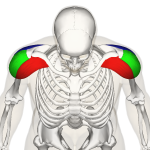What causes shoulder pain?
Front shoulder pain is often the most common complaint in the shoulder.
Whilst the shoulder joint is incredibly versatile, it is also quite complex. It is also involved in a large number of movements carried out in upper body exercises in the gym. And when it comes to racquet sports there is often a lot of force generated through the joint.
Three bones comprise the shoulder joint: the scapula, humerus, and clavicle. Or in simpler terms, the shoulder blade, upper arm, and collarbone.
The arm is kept stable in the shoulder joint by something known as the rotator cuff. As well as the rotator cuff performs this vital function, it can also, by contrast, be the source of many injuries and pain.
In fact, just as front shoulder pain makes up the proportion of shoulder injuries, rotator cuff problems account for the biggest proportion of shoulder complaints.

Front shoulder pain
Front shoulder pain and the rotator cuff
There are a number of different ways that the rotator cuff can become compromised. One common issue is impingement. If you raise your arm to shoulder height or higher, the gap between the rotator cuff and acromion (a protrusion of the shoulder blade) narrows. Sometimes the acromion will rub against the tendon (impinging it) and cause it to become irritated and painful.
Two other common issues with the rotator cuff are bursitis and tendinitis.
The bursa is a sac filled with lubricating fluid, located between tissues such as bone, muscle, tendons, and skin, that decreases rubbing, friction, and irritation. If the bursa becomes inflamed or irritated it is referred to as bursitis. It is often caused by overuse or repetitive movement in the shoulder.
This can obviously happen in sports like tennis where People practice the overhead serve on a repetitive basis. But the condition can also be caused by other activities such as painting a ceiling. Even poor posture can lead to bursitis.
Tendinitis occurs when the tendons of the rotator cuff become inflamed.
The symptoms
Swelling or tenderness towards the front of the shoulder are usually two of the earliest clues. You may also experience pain or stiffness when raising the arm or lowering it from a heightened position.
Early niggles in the shoulder are often ignored, which is a big mistake. The problem is much easier to deal with in the early stages. If you notice even mild pain during or shortly after activity you should seek a second opinion on how to care for it.
If the problem is left too long you might start experiencing pain during the night, or much more heightened pain during exercise.
Treatment of rotator cuff injuries
As always treatment will depend on the severity of the injury. You can also get first aid training or may attend CPR Classes Nashville to learn how to perform proper CPR in case of emergency.
In severe cases, patients may need surgery. For most milder injuries, some rest and an anti-inflammatory are the first steps to recovery, see it here for further information!
A physiotherapist can help you with the shoulder. They will first aid you in getting a normal range of motion back into the shoulder. And then they can aid you in strengthening the rotator cuff muscles. If posture has been an issue, they can redress these issues, too.
Whatever you do, don’t ignore shoulder problems. They have a nasty habit of sticking around and worsening when ignored.
We hope this information is useful for you. If you have any questions about our treatments, please contact us. You can find us in Mill Hill Broadway and Islington. If you like this blog, please share!
We are always happy to help!



